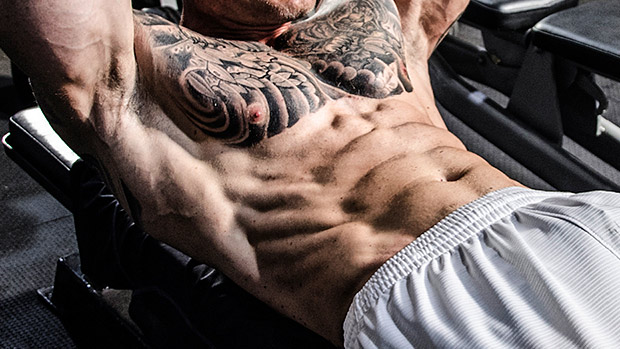Ab Crunches: Dangerous?
There's this growing idea that crunches are a dangerous exercise for your back. Many say they shouldn't be used, and they'll even allude to research from spine expert, Dr. Stuart McGill. However, here are two training recommendations taken from a 2017 paper on the crunch, coauthored by Dr. McGill:
"If maximal muscular development is the primary goal, including the crunch and/or its numerous variations, together with other exercises, may help to enhance desired results."
"If flexibility is more important to the client, the personal trainer may want to select full-range curl-ups and crunches, and reduce heavy loading."
So, sure, crunches may be problematic if you overuse them or apply them in a way that exceeds your physical capacity, but you could say that about any exercise. That's not an issue with crunches – it's an issue of poor application.
That said, I prefer stability-ball crunches over the standard floor crunches because they allow you to train the spinal flexion motion through a larger range of motion.
The Stability Ball Crunch
What About Posture and Functionality?
Many coaches also say that crunches will make your posture worse, and they're not a functional movement for sports.
First off, if you believe doing crunches will cause you to have a more flexed posture because that's the movement involved in the exercise, then you must also believe that doing Romanian deadlifts will lock you into spinal extension since that's involved in the exercise.
Secondly, many trainers choose to perform anti-spinal movement exercises to train the abs and they avoid spinal flexion exercises because they feel it's more functional for sports. They often call anti-spinal movement exercises like planks and plank variations "stability exercises," but they're really just isometric exercises.
The funny thing is, trainers and coaches don't call isometric biceps curls "elbow stability training," nor do they call isometric squats "knee stability training." That logical inconsistency aside, there are limitations of isometric training for performance because the strength gains it produces are extremely joint-specific and they transfer to those specific positions better.
Sure, anti-spinal movement exercises are great for helping to improve the function of the trunk musculature; it's the ability to remain stiff in order to transfer force between the hips and the shoulders. However, the torso doesn't just transfer force and reduce force by limiting movement. It also helps produce force by creating motion.
From MMA to tennis, you can't deny the obvious active movement role of the trunk in power production (force summation) during sporting events. Try to imagine Serena Williams serving a ball without moving her torso. You can also appreciate the active movement contribution the torso has in power production by trying a simple experiment.
First, perform an overhead soccer medicine ball throw. Use a medicine ball that's about 4-6 pounds. Then do it in the standard athletic fashion, where you extend at your spine and hips a bit (don't go to end range) in order to allow your (anterior) torso musculature to eccentrically load. Got that?
Then compare that to an anti-extension soccer-style throw where you don't allow your spine to move at all. You already know which of the two throws will be more powerful, not to mention which throw will feel more natural and athletic.
So based on what the principle of specificity dictates (and barring any injury), it makes the most sense to train both anti-spinal movements and active spinal in order to maximize your strength and performance.
References
- Lindh, M. (1979). Increase of muscle strength from isometric quadriceps exercises at different knee angles. Scandinavian Journal of Rehabilitation Medicine, 11(1), 33.
- Thépaut-Mathieu, C., Van Hoecke, J., & Maton, B. (1988). Myoelectrical and mechanical changes linked to length specificity during isometric training. Journal of Applied Physiology, 64(4), 1500-1505.
- Kitai, T. A., & Sale, D. G. (1989). Specificity of joint angle in isometric training. European Journal of Applied Physiology and Occupational Physiology, 58(7), 744-748.
- Weir, J. P., Housh, T. J., Weir, L. L., & Johnson, G. O. (1995). Effects of unilateral isometric strength training on joint angle specificity and cross-training. European Journal of Applied Physiology and Occupational Physiology, 70(4), 337-343.
- Ebersole, K. T., Housh, T. J., Johnson, G. O., Perry, S. R., Bull, A. J., & Cramer, J. T. (2002). Mechanomyographic and electromyographic responses to unilateral isometric training. The Journal of Strength & Conditioning Research, 16(2), 192.
- Folland, J. P., Hawker, K., Leach, B., Little, T., & Jones, D. A. (2005). Strength training: Isometric training at a range of joint angles versus dynamic training. Journal of Sports Sciences, 23(8), 817-824.
- Noorkõiv, M., Nosaka, K., & Blazevich, A. J. (2014). Neuromuscular adaptations associated with knee joint angle-specific force change. Medicine & Science in Sports & Exercise, 46(8), 1525-1537.
- Noorkõiv, M., Nosaka, K., & Blazevich, A. J. (2015). Effects of isometric quadriceps strength training at different muscle lengths on dynamic torque production. Journal of Sports Sciences, 33(18), 1952-1961.
- Shinkle J, Nesser TW, Demchak TJ, McMannus DM. J Strength Cond Res. 2012 Feb;26(2):373-80. Effect of core strength on the measure of power in the extremities.





